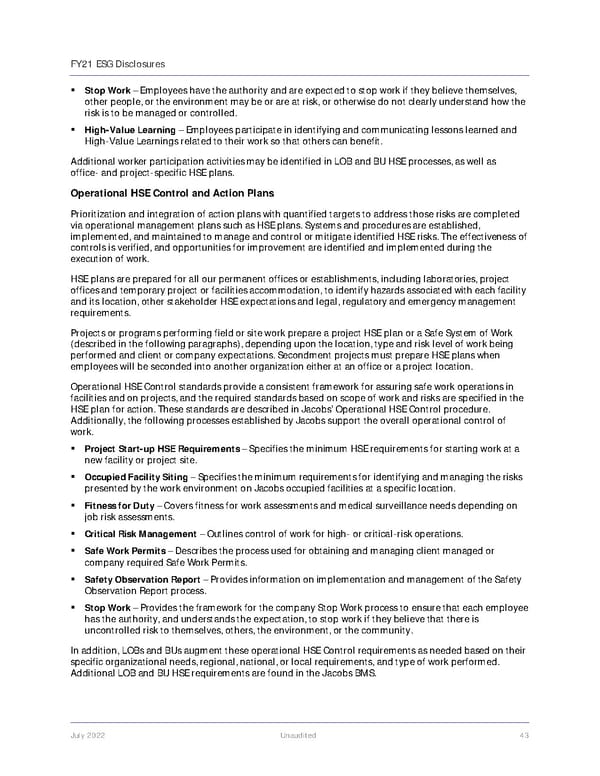FY21 ESG Disclosures July 2022 Unaudited 43 Stop Work – Employees have the authority and are expected to stop work if they believe themselves, other people, or the environment may be or are at risk, or otherwise do not clearly understand how the risk is to be managed or controlled. High-Value Learning – Employees participate in identifying and communicating lessons learned and High-Value Learnings related to their work so that others can benefit. Additional worker participation activities may be identified in LOB and BU HSE processes, as well as office- and project-specific HSE plans. Operational HSE Control and Action Plans Prioritization and integration of action plans with quantified targets to address those risks are completed via operational management plans such as HSE plans. Systems and procedures are established, implemented, and maintained to manage and control or mitigate identified HSE risks. The effectiveness of controls is verified, and opportunities for improvement are identified and implemented during the execution of work. HSE plans are prepared for all our permanent offices or establishments, including laboratories, project offices and temporary project or facilities accommodation, to identify hazards associated with each facility and its location, other stakeholder HSE expectations and legal, regulatory and emergency management requirements. Projects or programs performing field or site work prepare a project HSE plan or a Safe System of Work (described in the following paragraphs), depending upon the location, type and risk level of work being performed and client or company expectations. Secondment projects must prepare HSE plans when employees will be seconded into another organization either at an office or a project location. Operational HSE Control standards provide a consistent framework for assuring safe work operations in facilities and on projects, and the required standards based on scope of work and risks are specified in the HSE plan for action. These standards are described in Jacobs’ Operational HSE Control procedure. Additionally, the following processes established by Jacobs support the overall operational control of work. Project Start-up HSE Requirements – Specifies the minimum HSE requirements for starting work at a new facility or project site. Occupied Facility Siting – Specifies the minimum requirements for identifying and managing the risks presented by the work environment on Jacobs occupied facilities at a specific location. Fitness for Duty – Covers fitness for work assessments and medical surveillance needs depending on job risk assessments. Critical Risk Management – Outlines control of work for high- or critical-risk operations. Safe Work Permits – Describes the process used for obtaining and managing client managed or company required Safe Work Permits. Safety Observation Report – Provides information on implementation and management of the Safety Observation Report process. Stop Work – Provides the framework for the company Stop Work process to ensure that each employee has the authority, and understands the expectation, to stop work if they believe that there is uncontrolled risk to themselves, others, the environment, or the community. In addition, LOBs and BUs augment these operational HSE Control requirements as needed based on their specific organizational needs, regional, national, or local requirements, and type of work performed. Additional LOB and BU HSE requirements are found in the Jacobs BMS.
 Jacobs Engineering Group ESG Disclosures Page 43 Page 45
Jacobs Engineering Group ESG Disclosures Page 43 Page 45